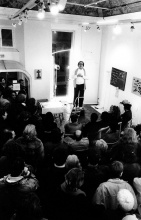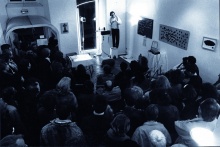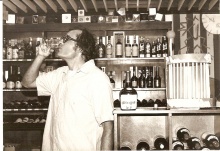Action: reading of Freud’s letter to Doctor Fliess of April 20, 1986 and chugging a glass of cognac.
Address by Jean Mas:
“This way to the good life!
If I chose the carrot, it is first because of the thickness of ‘care’ and ‘rut.’
We can thus believe that a thickness corresponds to something that, if someone cared, would have a sponsor.
Also, addressing myself to my hosts, I disclosed to them that I fished to do my Performance: ear nose and cognac.
This way to the good life!
I will stop in the beginning of this leek recipe to taste it.
As for the belch, the mouth’s indication of a ecclesiastical burp that, issuing in the belch, annuls the marriage.
In this holy climate and with what comes out of the mouth, we enter the discussion without taking a nose dive.
To summarize:
To remain in the mouth, the cognac that fills in for the leek and for the nose, the ear nose (carrot).
FREUD’S GLASS OF COGNAC
In 1984, Freud is 38 years old. He’s married, the father of five children. Other family members live with him. His clientele is far from being established. He has difficulty making ends meet. He’s accumulated some old debts.
At this time, Freud decides to apply his new method for the treatment of neuroses. He risks cutting himself off from his colleagues, isolating himself.
Freud suffers from heart problems and this worries him.
He thus turns himself to Doctor Fliess who then states that Freud only suffers from a hypersensitivity to nicotine.
“Regarding my pain, I hope that you’re right in believing that my nose is much of the problem and not my heart. Only a very harsh judge will hold against me the fact that I often think the opposite with this heart rate and inadequacy. I am not in a position to spend 1000 to 1500 guilders (2000 to 3000 francs) on my health or even half this sum, and I am not sufficiently demoralized to accept your proposition of sparing me the expense. Moreover, I think that this is not necessary. If the emphysema (sphenoid sinus, see the letter from April 26, 1895) is the core of the problem, the principal danger is then eliminated and a few more months of discomfort won’t kill me. If, on the other hand, the principal issue is a heart lesion, in this case you can only eliminate the secondary symptoms and I will then see myself facing the danger without warning, which I don’t want.
If I can write today, it is because I have high hopes. I have learned from this painful crisis (nasal, not heart), thanks to a dose of cocaine. I can only assure you that I will not come a day or two for a cauterization or a galvanization (here, Freud is talking about a chemical or electric cauterization), but even this is impossible for the moment. What I would ultimately want, is that you accept not wanting to know more about the heart issue.
I am pleased to now be entitled to expecting lots of news, and much more.
My warmest thoughts, your Sigm.”
Our ENT doctor had developed a concept about nasal reflex neurosis.
From his meeting with Freud, a friendship forms born of the admiration Freud has for the character and listening that Fliess has for our psychoanalyst research. They will even hold conferences together. Let us also note that the two doctors are interested in local dosages of cocaine.
And then, the relationship between the two men deteriorates. A certain distance establishes itself, most notably with the “Emma episode.”
Emma is a patient of Freud’s, being treated for hysteria. She suffers from abdominal pains (words of the stomach).
And Freud, like in other cases, asks his friend to please examine his patient so as to determine if she has turbinate dysfunction and sinus disease which would be able to partially explain her symptoms.
Fliess diagnoses some problems and suggests an operation.
So, Fliess will operate.
He operates on the patient and leaves. Only, postoperative complications arise:
foul suppurations, bleeding...
Freud, alone, calls another ENT (eyes, nose, throat doctor). However, this one notes that Fliess forgot 50 cm of gauze...
Upon removal of the gauze, the sick patient has serious hemorrhaging and loses consciousness. Freud who is helping with the intervention feels sick and has to leave the room. He recovers by drinking a little cognac
LADIES AND GENTLEMEN:
FREUD’S GLASS OF COGNAC.”






 ''
''